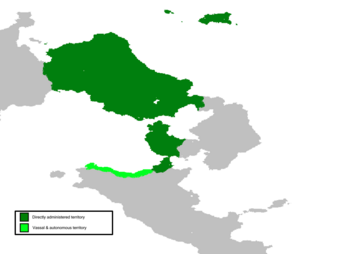Bilekian Empire: Difference between revisions
No edit summary |
No edit summary |
||
| Line 18: | Line 18: | ||
| symbol_type = | | symbol_type = | ||
| image_map = File:Bilekian Empire Map.png | | image_map = File:Bilekian Empire Map.png | ||
| image_map_caption = The Bilekian Empire at the outbreak of [[World War | | image_map_caption = The Bilekian Empire at the outbreak of [[World War 1 (Elezia)|World War One]] (1895) | ||
| capital = [[Sakarya]], [[Hausminia]] | | capital = [[Sakarya]], [[Hausminia]] | ||
| common_languages = {{plainlist}} | | common_languages = {{plainlist}} | ||
Revision as of 19:32, 1 February 2023
This article is incomplete because it is pending further input from participants, or it is a work-in-progress by one author. Please comment on this article's talk page to share your input, comments and questions. Note: To contribute to this article, you may need to seek help from the author(s) of this page. |
Bilekian Empire
| |
|---|---|
| c. 1389 to 1901 | |
 The Bilekian Empire at the outbreak of World War One (1895) | |
| Capital | Sakarya, Hausminia |
| Common languages | |
| Religion | Orthodox |
| Government | Mixed, functionally absolute monarchy |
| Historical era | Classical to Middle Ages |
| Today part of | |
The Bilekian Empire (Hausminian: Bilek İmparatorluğu) was an empire that controlled much of North-East Tarandra and the Aurean Sea from the 14th to early 20th century. The lands that made up the empire proper consists of mostly modern Hausminian land, with the empire situated around the capital of Sakarya which was conquered by Omar the Conqueror which brought rise to the early Bilekian Empire.
Etymology
The word Bilekian is a historical anglicisation of the name of Bilek I, the founder of the Empire and of the ruling House of Bilek (also known as the Bielkian dynasty). In Bilekian Turkish the empire was known as ʿAlīye-yi Bilek', literally "The Supreme Bilekian State"
History
Antiquity
1389 - As the Ucar Sultanate declined going well into the 14th century leaving List of geographical locations of Elezia to be divided into a patchwork of independent Hausminian principalities known as the Servetarazi beylits. On one of these beylits, in the modern region of Akcatepe (northern Hausminia) was lead by Bilek I, a figure of obscure origins from whom the name Bilekian is derived.
Rise
Fall
Demographics
Administration
References
See Also
